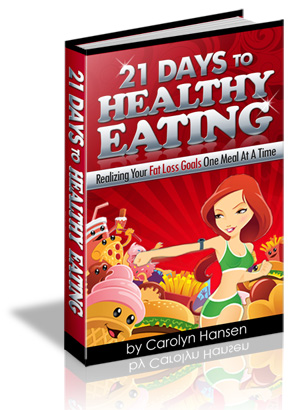
How Bad Is Our Modern Diet?
Our modern diet is a bit scary when you look at it, which is probably why most people choose not to. After all, we have to eat, and with the kind of high stress, busy lives we live, struggling to earn every dollar, who has the time to investigate their diet in any detail?
One person who does is Carolyn Hansen, and she has penned "21 Days To Healthy Eating" as a summary of her findings:
When thinking about the modern diet, to the average consumer, knowing whether or not a given food item is healthy or not is not only a confusing endeavor, it is time wise costly. Have you studied food labels lately? They are not easy to decipher. If you have to stop and analyze each new food item you come across in your local store you are going to be moving through the aisles very, very slowly. Most people simply do not have the time, even if they knew what it was they were looking for in the food labeling.
Most food companies are betting on the fact that their customers do NOT have the time for a proper analysis of the labels, and that they will only make a cursor scan of the total number of calories, and the number of grams of fat, and perhaps sodium content.
These are all important numbers, but they do not tell the entire story. On low fat items the number of calories tends to be harder to find than the number of grams of fat. Why? Because consumers who discover that the product is indeed low in fat grams are less likely to pay attention to the total number of calories, which is the really important number when in comes to weight loss. It does not matter if the product is low in fat if it also happens to be loaded with sugar. It is the number of calories that is going to determine whether or not you gain weight, not the total fat content.
So foods that appear to be healthy may not be healthy at all. You will find cereals advertised as being good for your heart when in fact their high sugar content means that exactly the opposite is true. The Nobel prize winning chemist Linus Pauling believed that fructose, the naturally occurring sugar found in fruits, was the real culprit behind the rise in coronary disease in the twentieth century. Fructose is found in equal parts with glucose in table sugar, and is added to just about every food that has been sweetened for taste.
Pauling believed that fructose is broken down into acetate (think nail polish) which is a precursor to the creation of cholesterol which is synthesized in the liver. This was not Pauling's idea, but actually the conclusion of work of other chemists. But does anyone warn you today about eating too much sugar when it comes to the discussion of coronary disease? No, we get a lot of advice about avoiding meats which are high in cholesterol. But ingested cholesterol does not go directly into the bloodstream, whereas sugar floods in every time we down another sticky bun.
This is just one example of the difficulty the consumer has in figuring out what is healthy and what is not when it comes to the modern diet. Pauling's ideas about fructose and cholesterol were certainly not shared by all nutritionists. Most doctor's today would not even know that there is a connection between fructose and cholesterol. So if physicians themselves are misinformed on important matters like the cholesterol/fructose connection, consumers are certainly not to be blamed for making the wrong choices when it comes to their diet.
This is just one example of the very large subject that we characterize by the term "healthy eating". If you want to learn the basics of the subject, and learn a practical no-stress approach to selecting foods from your grocery store so that you can prepare healthy meals with relative ease, check out Carolyn's book "21 Days To Healthy Eating"
This is about the easiest way I know of taking a complex subject and boiling it down to the essence so as to save you time and provide you with an actionable plan that will have you eating healthy foods for the majority of your meals in just a few short weeks.